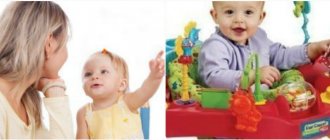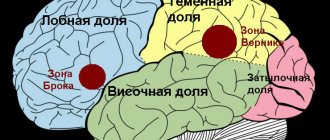Published: 05/17/2020 Category: Interesting
Good day, dear readers. Today I want to discuss this topic - who are bilingual children? I asked myself this question when I found out that a friend was planning to move with her entire family to Hong Kong. My husband has been transferred for work and they are leaving with two small children. They know Chinese, but they are worried about how the children will develop. After all, they will have to learn a second language.
- 1 The phenomenon of bilingualism
- 2 Formation of bilingualism in children
- 3 Types of bilingualism
- 4 Dangers and difficulties
- 5 What to pay attention to
- 6 Setting family rules
- 7 Conclusion
The phenomenon of bilingualism
Bilingualism is the ability to speak two languages fluently. At the same time, they are both perceived as family. And the brain easily switches from one to another.
If we are talking about children, then by the time they start speaking, they do it simultaneously in two languages. Because of this, difficulties may arise with speech production. Without a special training system, it can become like mush.
In addition, bilingual children are more likely to suffer from nervous breakdowns and stuttering. Therefore, parents are always faced with the question of how to teach two different linguistic constructions at the same time. So that the process goes harmoniously and does not harm the baby.
How to overcome the problems of bilingualism
To minimize the complications that accompany bilingualism in preschool children, it is necessary, first of all, to choose the optimal upbringing option and strictly adhere to it. The next step is to follow a number of fairly simple rules, namely:
- never correct the first mistakes (especially in front of strangers), allow the child to express the thought to the end, even if he mixes languages;
- consider the importance of immersion in the cultural environment of the language, tell more about the history and traditions of the countries;
- Use age-appropriate teaching methods, from fun flashcard games and cartoons to progressive grammar exercises.
The learning process should be fun, unobtrusive and non-tiring. If we are talking about the child’s purposeful learning of a second language, motivation will not be superfluous - an explanation of the importance of classes, encouragement for the success achieved.
And of course, raising a bilingual child, like any child, requires patience, love and care, and a guaranteed result will be ensured by the involvement of professionals in the process, including the children’s attendance at specialized preschool institutions.
Types of bilingualism
- Congenital or early . When a baby hears multilingual words from birth and begins to speak two languages at once.
- Late . When a child’s development in a foreign environment occurs after the age of three.
- Artificial . If parents deliberately try to raise a bilingual, there are no foreigners in the family.
According to the degree of development, pure and mixed types are distinguished.
- Clean . When a baby calmly talks to mom in one language, and to dad in another. Speaks clearly, legibly, without foreign borrowings.
- Mixed . There is no conscious separation of languages, words are mixed, grammatical structures are confused.
Natural and acquired causes of bilingualism
Proficiency in two languages at the native level, or bilingualism, has many classifications, but one of the main ones can be considered the one based on the age and mechanism of language acquisition. On this basis, bilingualism is distinguished:
- early or congenital (natural) - arising if two languages are present in the baby’s life from birth (for example, in international or emigrant families: in the first case, the speech of the father and mother is different, in the second - the language used within the family differs from the language of communication with others );
- late (acquired) - occurs against the background of mastering a foreign language as a second native language at a later age (for example, among emigrant children who are immersed in a language environment in a new country, learning a new tool of communication directly in the culture).
The scenarios that give rise to bilingualism can be different, including the deliberate involvement of a foreign nanny in raising a child, placing him in a specialized institution (for example, in a kindergarten with foreign language training), etc.
Acquired bilingualism and conventional second language learning must be distinguished: bilinguals acquire vocabulary and grammar not through textbooks, but through socialization.
At the same time, scientists believe that the probability of one hundred percent mastery of “foreign” language structures and phonetics decreases significantly upon reaching the age of 8-11 years - even if there is a move to the country of the language being mastered and/or adoption by its native speakers.
Dangers and Difficulties
Families with bilingual children often experience difficulties with speech development. This happens because the fragile children's brain is subject to increased stress. Extreme forms can lead to its complete disappearance. This phenomenon is called “mutism”.
It is precisely because of the increased brain load that such children begin to talk later than their peers. Therefore, when entering a preschool educational institution, they still communicate with sounds or gestures, which makes communication difficult.
The baby's central nervous system is seriously affected. Such children are more likely to suffer from stuttering, stress, and are more susceptible to nervous breakdowns.
It is not uncommon for bilinguals to grow up with obvious speech impairments. They find it difficult to learn diverse grammatical structures. Therefore, their conversation is a kind of mixture of foreign words. This often causes problems with understanding and explanation. As a result, problems with reading and writing appear.
Myths and truth about bilinguals
To understand whether bilingualism is beneficial or harmful, you need to dispel the myths around this concept. Let's look at some of them:
Myth: bilingualism causes delays in the development of speech and thinking in children.
Truth: Bilingual children develop at the same rate as monolingual children. Even if a baby confuses words or mixes part of a word from one language with part of a word from another, this is not considered a sign of abnormal speech development. A little time will pass, and he will easily distinguish between the vocabulary of each language.
- Myth: Learning two languages at the same time can confuse your child.
Truth: Yes, children can confuse grammatical rules and other language patterns from time to time. But by the age of 4-5 these difficulties are a thing of the past. The better he gets to know both languages, the clearer the line between them will be.
- Myth: Children with speech problems cannot learn a second language.
Truth: These children tend to have more difficulty learning two languages, but that doesn't mean it's insurmountable. You will have to spend more time to achieve an equally high level of proficiency in both languages.
- Myth: Bilingual children may have problems in school.
Truth: Numerous studies have shown that bilingualism has a number of academic benefits. These include valuable skills in multitasking, cognitive flexibility, and quickly finding the right solution.
- Myth: Children who simply know a second language are already bilingual.
Truth: To be considered bilingual, you need to know and use both languages approximately equally. Yes, a dominant language is possible, but regular practice of using and developed vocabulary of the second language is an indispensable condition for bilingualism.
What to pay attention to
Clarifying the answer to the question - who are bilingual children, the next step is to find out how to help your child develop harmoniously. If noticeable speech deviations are observed from an early age, you should immediately contact a speech therapist. To correct serious violations, the help of a psychologist may be required.
Parents have the power to help their children master various language forms as easily as possible. We must strive to ensure that by the time the baby speaks, he can already distinguish foreign words.
Problems of raising bilingual children
Even in cases where parents are well aware of their children's language abilities, they should not feel falsely reassured. Adults may think that it is enough to speak to each other in different languages so that children hear speech and learn to understand it. Psychologists say that mastering a language requires enormous contact. It's about talking to young children as much as possible, reading aloud and singing to them.
To avoid problems in bilingual education of a child, it is necessary to provide massive language exposure. Moreover, it must be personal; it cannot be delegated to a TV or tablet. According to pediatricians, screen time does not help children's language learning, even with monolingual upbringing, and even more so when raising bilinguals. With the help of a screen, children can receive information and improve their vocabulary, but speaking abilities develop only through personal communication. Parents must understand this and get involved in the learning process as much as possible.
Setting Family Rules
- As soon as the baby begins to speak, it is necessary to clearly distinguish between languages. Correct him if during a conversation he begins to mix up foreign words. By the age of 3-4, the brain has mastered most grammatical structures and there should no longer be problems with confusion. Therefore, already from kindergarten, the baby can comfortably maintain communication.
- Follow the rule “each parent uses only his own language.” This will simplify the task and also minimize confusion between linguistic constructs. Your goal is to form the habit of hearing speech forms from different speakers.
- Set a rule - you use one language in public places, and another, for example, at home. It can also be differentiated based on time. One in the morning and afternoon, another in the evening.
- It is very important to give older children foreign books to read so that they can more easily grasp grammatical structures. At the same time, remember the need to alternate texts.
How to raise a bilingual child
There is one axiom: the larger the volume of the language, the faster it learns. There are so-called language inputs - sources of foreign vocabulary. This could be books, films, communication with other people in the target language, studying, traveling and even computer games. The number of inputs and the degree of their impact on bilingual children predict both vocabulary and speed of language acquisition.
A good place to start is by increasing the number of language inputs. Try to have as many of them as possible in the first stages, and for in-depth language learning, increase the intensity of exposure.
Example:
- The child learns English with the help of: mother (native speaker) + books + lessons at school + music + literature.
- The child already knows the language, but it is necessary to expand his vocabulary. Therefore, we are deepening the entry points: you need not just read the book in English, but also discuss it with the teacher and write an essay based on the plot.
What else can you do
✓ You can achieve progress in everyday language learning with the help of loved ones. People from different generations often have different vocabulary, and the more variations (dialects, slang, professional terms, outdated words) a child has access to, the better.
✓ Use the “one person, one language” approach in mixed families (parents from different countries), as well as “one situation, one language” for the migration type of child bilingualism (at home - the native language, in society - the studied one).
✓ Systematize your knowledge with the help of a teacher. No matter how well a child communicates in the languages they are learning, it is better to learn the rules of grammar and spelling in an academic way.
✓ If interest in one of the languages is gradually lost, spur it on by enrolling your child in a class/section where they will speak exclusively in this language. The combination of hobbies and learning will bring good results.
4/ One language - one contact
Myth or Truth: Children Should Speak to Each Parent in the Established Language
Myth . The theory of adopting a "one parent, one language" approach to bilingual families was popular 100 years ago. Experts advised creating such associativity out of fear that otherwise children might experience intellectual fatigue or confusion. Today it has been established that such an approach is neither necessary nor sufficient for the successful acquisition of two languages. Parents can follow any strategy that promotes qualitative and quantitative language learning. For example, with reference to a person (one person - one language), place (one language at home - one outside the home), time (hours or days of the week). At the same time, experts note that a flexible approach without fixed rules is not a mistake. This experience leads to a balanced and positive interaction with the child.
2/ When do bilingual children start speaking?
Myth or truth: bilingual children begin to speak later than their peers
Is it true . A child growing up in a multilingual family is often in no hurry to say his first words. However, this has nothing to do with intellectual development. It just takes time for the brain to organize the information it receives before using it.
“My husband and I speak English, he and his parents communicate with our daughter Emma in German, and my family and I chat with her in Russian,” says Natalya. — When the girl was a year and a half old, at the family council they began to sound the alarm: the child does not speak! To clear my conscience, I went to a child psychologist, heard a soothing “Mom, don’t worry” - and literally a week later the child surprised us. Emma was playing with her grandfather, and he jokingly told her in German to tell her mom that it was time for dinner. The child fulfilled the request exactly, and automatically translated the phrase into Russian - especially for me.”
In order for the development of several languages to proceed harmoniously, parents of bilingual children will have to ensure that speaking is supported by reading and the ability to write in these languages.









